To preserve herb flavors while drying, start with fresh, high-quality herbs, and harvest them at their peak. Choose the right drying method—air drying, oven drying, or using a dehydrator—depending on your needs. Maintain ideal temperatures by keeping conditions cool and avoiding direct sunlight to protect essential oils. Store dried herbs in airtight containers to limit exposure to air and moisture. You can also enhance flavors with spices and create custom blends. Finally, label your containers for organization. Stick around, and you'll discover even more tips to maximize the taste of your dried herbs!
Select Fresh, High-Quality Herbs
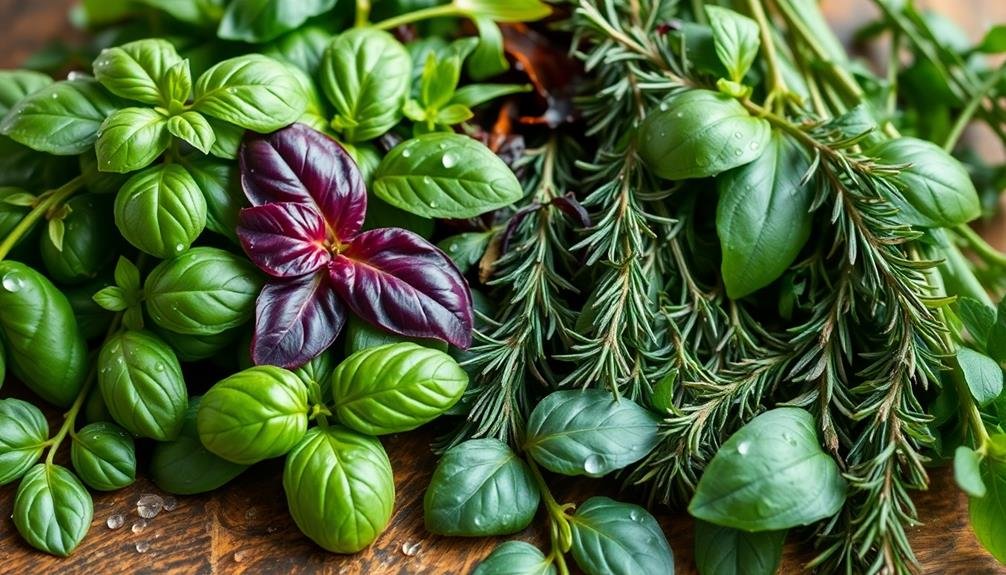
Selecting fresh, high-quality herbs is essential for preserving their vibrant flavors. When you head to the market or your garden, look for herbs that showcase rich colors and a robust aroma. Fresh herbs should feel firm and crisp, not wilted or limp. If you can, gently rub a leaf between your fingers; the fragrance should be intense and inviting, signaling that the herb is at its peak.
Inspect the leaves closely for any signs of discoloration, pests, or damage. Avoid herbs that have yellowing leaves or any signs of decay. If you're buying from a store, check the packaging for freshness dates, and opt for organic when possible to verify you're getting the best quality.
Pay attention to the seasonality of herbs, too. Choosing herbs that are in season not only supports local farmers but also assures maximum flavor.
When you select high-quality herbs, you're setting the foundation for delicious flavors in your dishes. Remember, the quality of your herbs directly impacts the final taste, so take your time and choose wisely.
Use Proper Harvesting Techniques
Once you've chosen fresh, high-quality herbs, it's important to know how to harvest them properly to maintain their flavor and energy.
Start by selecting the right time of day; early morning is ideal since the herbs are most aromatic and flavorful after the dew has evaporated. Use sharp scissors or pruning shears to make clean cuts, which minimizes damage to the plant.
When you're harvesting leaves, snip them just above a leaf node. This encourages further growth and guarantees you'll have more herbs later.
Avoid taking too many leaves from a single plant at once; aim to harvest about one-third of the plant to keep it healthy.
If you're gathering flowering herbs, cut them just as the buds begin to open. This timing captures the peak flavor and aroma.
Choose the Right Drying Method
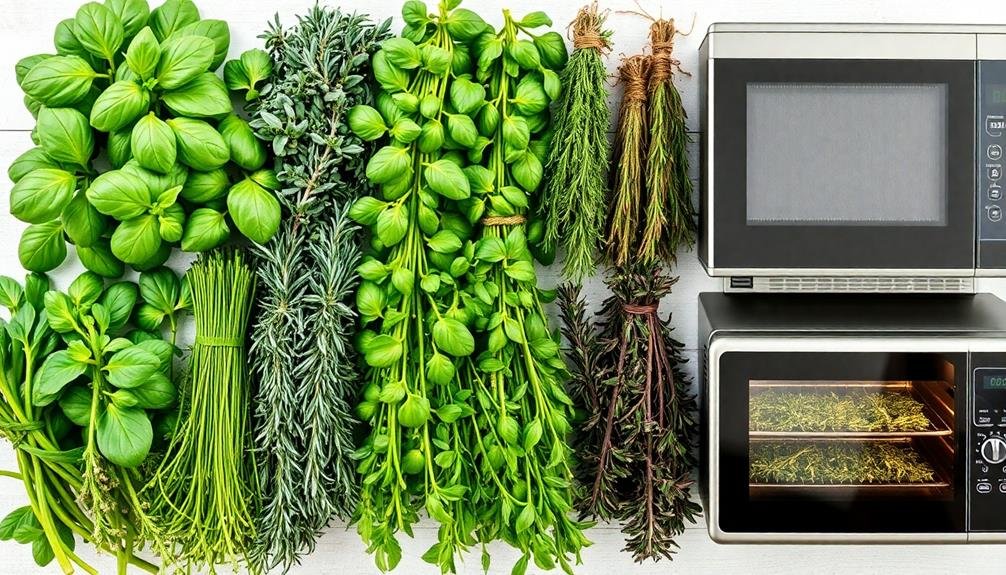
When it comes to drying your herbs, choosing the right method can make all the difference in flavor retention.
You can opt for air drying, oven drying, or using a dehydrator, each with its own set of benefits.
Let's explore these techniques to find the best fit for your herbs.
Air Drying Techniques
Air drying herbs is a simple yet effective way to preserve their vibrant flavors. To get started, choose fresh, healthy herbs without any signs of damage or disease. Gather them into small bundles, tying the stems together with a string or rubber band. Make certain the bundles aren't too tight, as air circulation is essential for proper drying.
Next, find a warm, dry, and well-ventilated area in your home, away from direct sunlight. A kitchen or pantry with good airflow works well. Hang the bundles upside down from a hook, a nail, or a clothesline. If you're short on space, you can also lay the herbs flat on a clean, dry surface like a drying rack or a paper towel.
Check your herbs daily to verify they're drying evenly. Depending on the humidity and the type of herb, drying can take anywhere from a few days to a couple of weeks. When they're fully dried, the leaves should feel crisp and crumble easily.
Store your dried herbs in airtight containers, away from light and moisture, to maintain their flavors for as long as possible.
Oven Drying Tips
If you're short on time or live in a humid climate, using your oven can be a quick and efficient way to dry herbs while preserving their flavors. Here are some essential tips to guarantee you get the best results:
- Preheat Your Oven: Set your oven to the lowest temperature, ideally around 170°F (77°C). This helps prevent cooking the herbs, allowing their natural oils to remain intact.
- Use a Baking Sheet: Spread your herbs evenly on a baking sheet lined with parchment paper. Avoid overcrowding, as this can lead to uneven drying.
- Check Frequently: Herbs can go from perfectly dried to burnt in a flash. Check them every 30 minutes and give them a gentle stir to promote even drying.
- Store Properly: Once dried, let your herbs cool completely before transferring them to airtight containers. This keeps them fresh and flavorful for longer.
Dehydrator Best Practices
Using a dehydrator is one of the best ways to preserve herb flavors effectively. To get the most out of your herbs, start by selecting the right dehydrator. Look for one with adjustable temperature settings, as different herbs require varying heat levels. Generally, a temperature between 95°F and 115°F works best for most herbs, allowing them to dry without losing their essential oils.
Next, prepare your herbs by washing and thoroughly drying them. Remove any damaged leaves and chop larger herbs into uniform pieces to guarantee even drying. Spread the herbs in a single layer on the dehydrator trays. Avoid overcrowding; this allows for proper airflow and prevents moisture buildup.
Check the herbs periodically for doneness. Most herbs are ready when they feel dry and crumbly to the touch.
Once dried, let them cool before transferring to airtight containers. Store them in a cool, dark place to maintain flavor over time. By following these best practices, you'll be able to enjoy the vibrant flavors of your herbs long after the growing season is over.
Happy dehydrating!
Maintain Optimal Temperature Control
When it comes to preserving herb flavors, maintaining ideal temperature control is essential. Too high a temperature can diminish those bright, aromatic qualities you love, while too low can lead to slow drying and potential mold.
Here are some tips to help you keep that perfect balance:
- Use a thermometer – Investing in a reliable thermometer lets you monitor the drying environment closely, ensuring you stay within suitable temperature ranges.
- Set your dehydrator correctly – Most herbs dry best at temperatures between 95°F and 115°F (35°C to 46°C). Adjust your dehydrator setting to match this range for the best results.
- Check regularly – Keep an eye on your herbs as they dry. If you notice them wilting or browning, it's a sign the temperature is too high. Lower it immediately!
- Be patient – Rushing the drying process can lead to loss of flavor. Take your time and let the herbs dry slowly and evenly for maximum taste retention.
Avoid Direct Sunlight Exposure
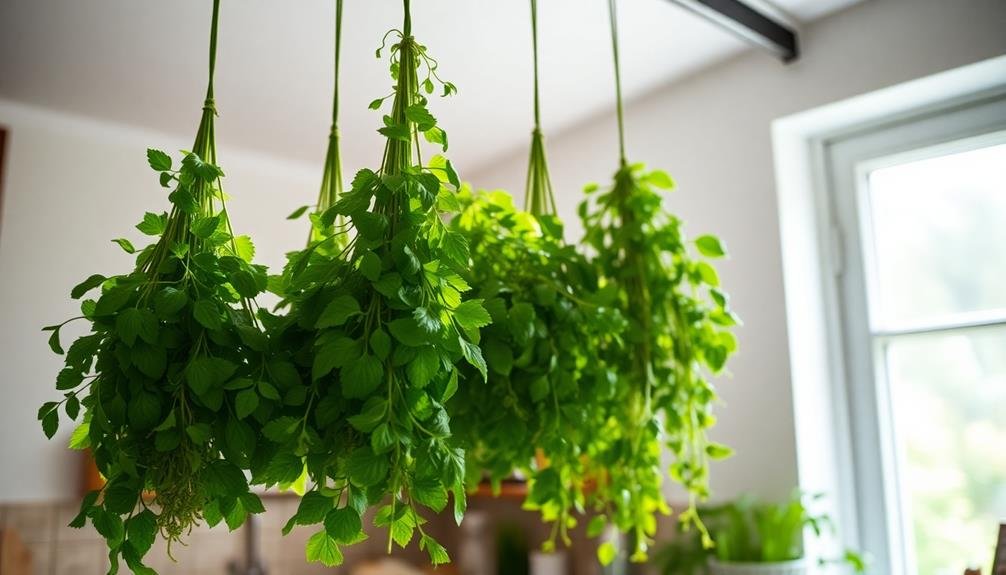
Direct sunlight can be a herb's worst enemy, as it speeds up the drying process and strips away delicate flavors. When herbs are exposed to direct sunlight, the heat can cause essential oils to evaporate too quickly, resulting in a loss of the very characteristics you want to preserve.
To avoid this, always choose a shaded area for drying your herbs. If you can, use a drying rack or hang herbs in a cool, dark space.
A well-ventilated area will protect them from sunlight while allowing moisture to escape. You might consider using a cloth or screen to cover your herbs, providing an extra layer of protection against those harsh rays.
Utilize Airflow for Even Drying
To guarantee your herbs dry evenly, proper spacing is key.
Using fans can help create ideal airflow, preventing moisture buildup that leads to spoilage.
Keep in mind the best drying conditions to maintain those vibrant flavors you love.
Proper Spacing Techniques
Proper spacing techniques are essential for preserving the vibrant flavors of your herbs. When herbs are too crowded, they trap moisture and hinder airflow, leading to uneven drying and potential mold growth.
To guarantee your herbs dry properly, consider these tips:
- Spread Them Out: Lay your herbs in a single layer on drying racks or trays. This allows air to circulate freely, guaranteeing even drying.
- Leave Space Between Bunches: If you're drying larger bunches, make sure to leave space between them. This will promote airflow and prevent the bunches from sticking together.
- Rotate Your Trays: If you're using multiple trays, rotate them halfway through the drying process. This helps expose all sides of the herbs to airflow and light.
- Use a Mesh or Wire Rack: Opt for drying surfaces that allow air to flow beneath and around the herbs. A mesh or wire rack is ideal, as it prevents moisture from accumulating underneath.
Use of Fans
Using fans can greatly enhance the drying process of your herbs by promoting consistent airflow. When you're drying herbs, stagnant air can lead to uneven drying and may even foster mold growth. By utilizing fans strategically, you can guarantee a steady stream of air that helps moisture escape more effectively.
Here's a simple overview of how to set up fans for ideal drying:
| Fan Position | Airflow Direction | Benefits |
|---|---|---|
| Above the herbs | Downward | Distributes air evenly |
| At the sides | Horizontal | Prevents moisture pockets |
| Below the herbs | Upward | Encourages moisture release |
Positioning your fans correctly is key. The goal is to create a gentle breeze that allows the herbs to dry evenly without damaging their delicate structure. Check on them regularly to guarantee that the airflow remains consistent, and you'll find that your herbs retain more flavor and aroma after drying.
Optimal Drying Conditions
Creating ideal drying conditions is essential for preserving the flavors of your herbs. One of the most effective ways to achieve this is by ensuring proper airflow. When you allow air to circulate around your herbs, it helps prevent moisture buildup and promotes even drying.
You'll want to keep the following tips in mind:
- Use racks or screens: Elevate your herbs on racks or screens to enhance airflow underneath, preventing dampness that can lead to mold.
- Space your herbs out: Don't overcrowd your drying area. Give each herb enough space to breathe, which allows air to flow freely between them.
- Choose the right location: Opt for a dry, well-ventilated space away from direct sunlight. This protects the delicate oils and vibrant colors of your herbs.
- Consider using a fan: A gentle fan can help maintain consistent airflow, ensuring that your herbs dry evenly without losing their aromatic qualities.
Experiment With Quick Drying
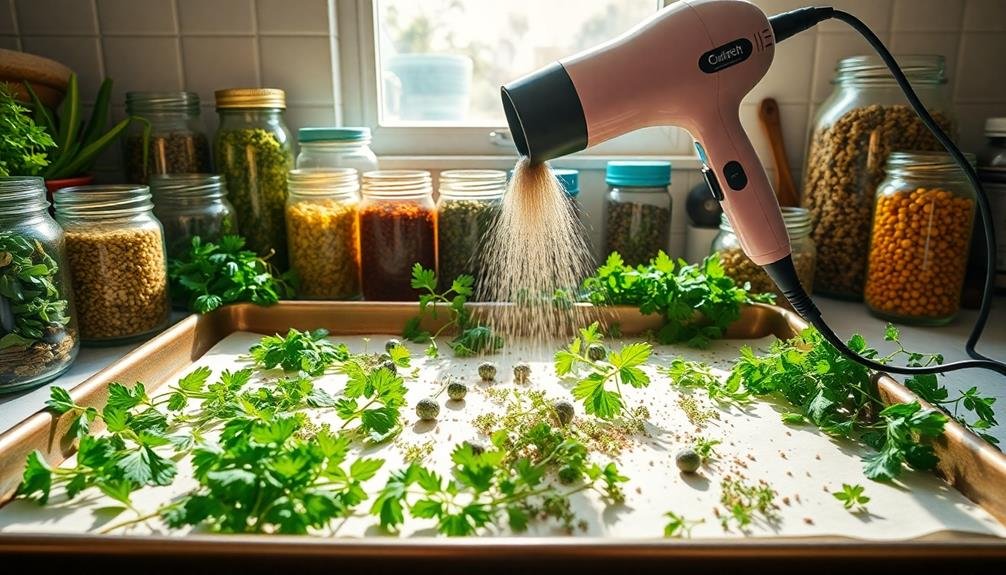
When you're looking to preserve herb flavors, quick drying can be a game changer. This method helps retain the essential oils and vibrant colors of your herbs, ensuring they keep their signature taste.
To start, gather your fresh herbs and rinse them gently to remove any dirt. Pat them dry with a clean towel.
Next, consider using a microwave for rapid drying. Spread the herbs in a single layer on a microwave-safe plate and cover them with a paper towel. Microwave in short bursts of 20 to 30 seconds, checking the herbs' dryness between intervals. You want them to feel crisp but not scorched.
Alternatively, you can use an oven set to the lowest temperature. Arrange the herbs on a baking sheet lined with parchment paper and leave the oven door slightly ajar. This allows moisture to escape while preventing overheating. Keep a close eye on them, as this method can dry herbs quickly.
Lastly, a food dehydrator is another excellent option for quick drying. Set the temperature according to the type of herb, and let it work its magic.
Experiment with these methods to find what best preserves your herbs' delightful flavors.
Store in Airtight Containers
To keep your herbs fresh, you need to store them in airtight containers.
Choosing quality containers and maintaining ideal storage conditions can make a big difference.
Don't forget to label and date your herbs, so you always know what you have on hand.
Choose Quality Containers
Choosing the right containers is crucial for preserving the vibrant flavors of your herbs. When you invest in quality storage, you guarantee that your hard work in growing and drying herbs pays off.
Here are four important characteristics to look for in your containers:
- Airtight Seal: Make sure your containers have a tight-fitting lid to keep moisture and air out, preventing spoilage.
- Opaque Material: Choose dark or opaque containers to shield your herbs from light, which can degrade their flavor and potency over time.
- Glass or Food-Grade Plastic: Opt for glass or high-quality food-grade plastic. These materials won't impart any unwanted flavors or odors to your herbs.
- Size Varieties: Select different sizes based on the amount of herbs you have. Smaller containers are great for frequently used herbs, while larger ones work well for bulk storage.
Optimal Storage Conditions
Storing your herbs in airtight containers is crucial for maintaining their fresh flavors and aromas. When herbs are exposed to air, they can quickly lose their potency and become stale. Choose containers made of glass or high-quality plastic, as these materials provide the best seals.
Verify the containers are completely dry before placing your herbs inside; moisture can lead to mold and spoilage.
Keep your airtight containers in a cool, dark place, away from direct sunlight and heat sources. Light and heat can degrade essential oils in herbs, diminishing their flavor and aroma over time. A kitchen cabinet or pantry is often a suitable location.
You should also avoid placing the containers near spices or strong-smelling foods, as herbs can absorb these odors. When you store herbs correctly, you'll enjoy better flavor in your dishes, enhancing your culinary creations.
Regularly check your herbs for any signs of moisture or spoilage, and confirm you're sealing the containers tightly after each use. With these ideal storage conditions, you'll preserve the true essence of your dried herbs, making them ready to elevate your meals whenever you need them.
Label and Date Herbs
While you might think all herbs are the same, labeling and dating them can greatly enhance your organization and assure freshness. When you dry and store your herbs, it's vital to confirm you know what you've got and how long it's been sitting around.
This simple act can save you from disappointing culinary experiences!
Here are four reasons why labeling and dating herbs is essential:
- Avoid Confusion: No more guessing games! You'll know exactly what you're grabbing from your pantry.
- Maximize Flavor: Using fresher herbs means richer flavors in your dishes, elevating your cooking to new heights.
- Minimize Waste: By keeping track of when you dried your herbs, you can use them before they lose potency.
- Create a Personal Touch: Your labeled jars can reflect your personality and style, making your kitchen feel more inviting.
Incorporate Flavor Enhancers
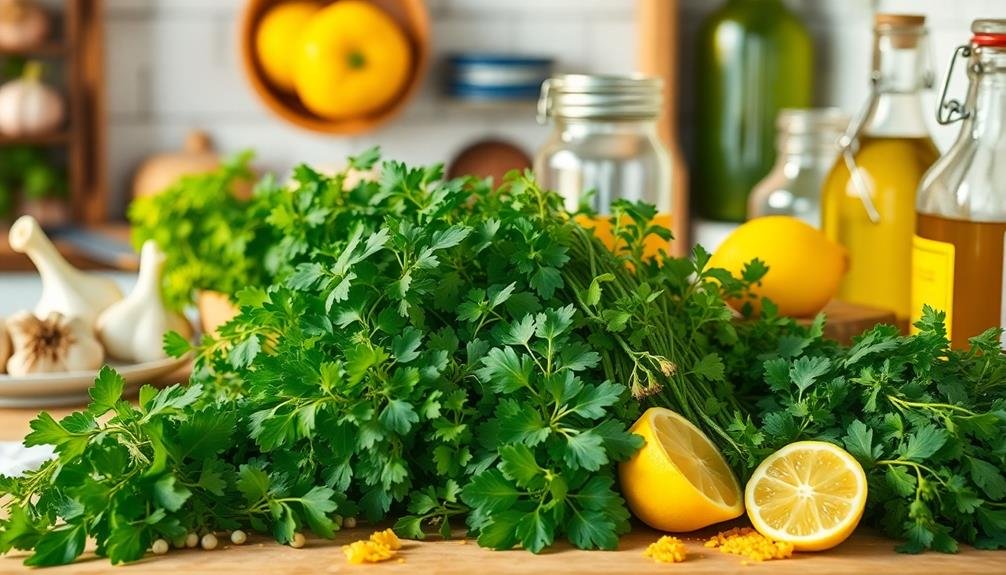
To elevate the flavors of your herbs, incorporating flavor enhancers can make a considerable difference. When you dry your herbs, they may lose some of their natural oils and aromatic compounds. Adding complementary ingredients not only boosts the flavor but can also create a unique blend that excites your palate.
Consider mixing your dried herbs with spices like garlic powder, onion powder, or paprika. These can add depth to your herb mixtures and help maintain a vibrant flavor profile. You might also experiment with citrus zest, such as lemon or lime, which can brighten the overall taste and make your herbs more versatile in various dishes.
Another great option is to include dried chilies or chili flakes for a kick of heat. This adds complexity and can enhance the flavors of your herbs considerably.
Don't forget to try out salt blends or flavored salts; they can be a fantastic way to incorporate herb flavors into your cooking seamlessly.
Label and Organize Your Herbs
An effective way to maintain the freshness and flavor of your herbs is by labeling and organizing them properly. When you take the time to do this, you'll not only find what you need quickly, but you'll also preserve the unique characteristics of each herb.
Here are four essential steps to get you started:
- Use Clear Labels: Invest in waterproof labels or markers. Write the herb name and drying date, so you can track freshness easily.
- Create a System: Organize your herbs by type, flavor profile, or usage. This will make it easier to find what you need when cooking.
- Store in Airtight Containers: Choose glass jars or vacuum-sealed bags. This helps keep moisture out, preventing mold and preserving flavor.
- Keep a Herb Inventory: Maintain a simple list of your dried herbs. This way, you won't forget what you have on hand, and you can plan meals accordingly.
Frequently Asked Questions
Can I Mix Different Herbs for Drying Together?
You can mix different herbs for drying, but be mindful of their drying times and flavors. Some herbs may overpower others, so choose complementary ones to create a balanced blend that enhances your culinary creations.
How Long Can Dried Herbs Be Stored Effectively?
You can effectively store dried herbs for about one to three years. Keep them in a cool, dark place in airtight containers to maintain flavor and potency, and avoid exposure to light and moisture for best results.
What Are Some Signs of Improperly Dried Herbs?
If your herbs feel damp, have a musty smell, or show signs of mold, they're improperly dried. You should discard them to avoid health risks and guarantee you're using quality herbs in your cooking.
Are There Specific Herbs That Dry Better Than Others?
Yes, some herbs dry better than others. Oregano, thyme, and rosemary retain their flavors well, while basil and parsley tend to lose more flavor during the drying process. Choose herbs wisely for best results.
Is It Safe to Dry Herbs in the Microwave?
Yes, you can safely dry herbs in the microwave. Just place them between paper towels, use short intervals, and check frequently. This method's quick but keep an eye on them to avoid burning.
In Summary
By following these ten methods, you can effectively preserve the vibrant flavors of your herbs while drying. Selecting high-quality herbs, using the right drying techniques, and storing them properly are key steps to maintaining their taste. Don't forget to experiment with quick drying methods and consider flavor enhancers to elevate your culinary creations. With a little care and attention, your dried herbs will be a flavorful addition to your dishes, ready to impress. Happy drying!

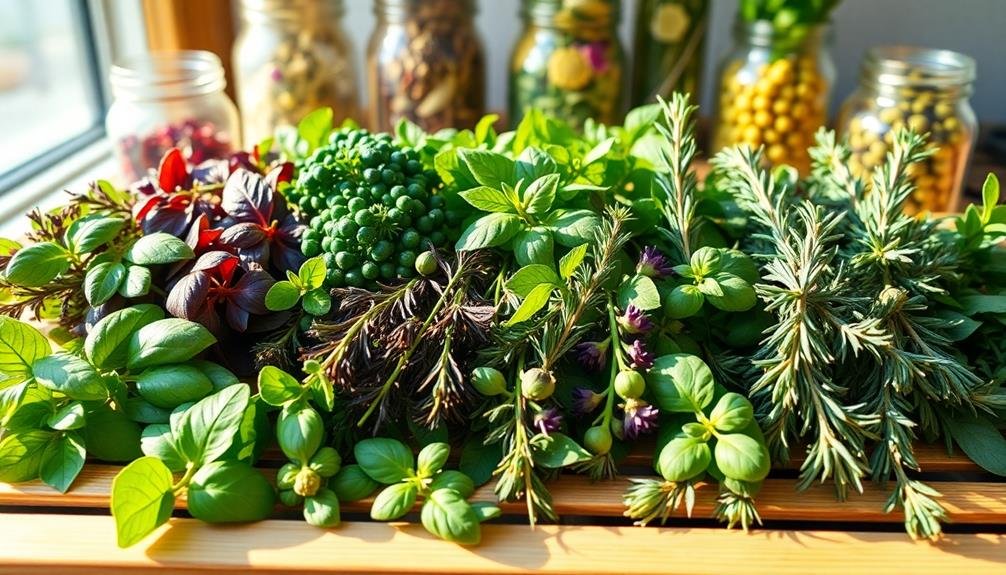



Leave a Reply